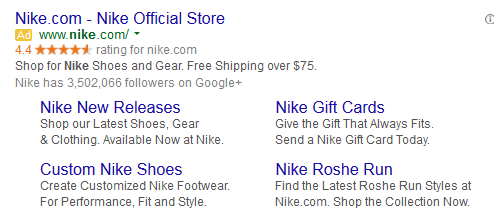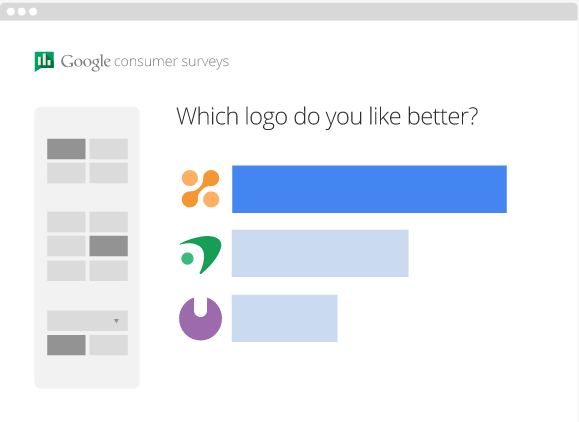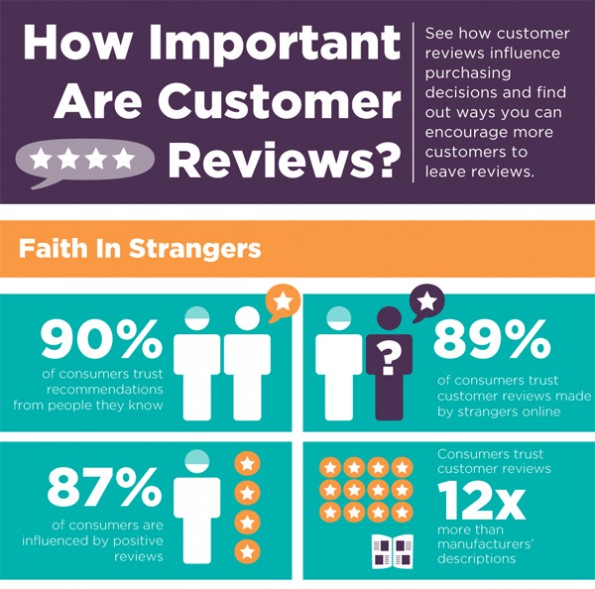What’s a surefire (free) way to generate revenue for your business? Get great reviews from your customers! This guide will cover the factors needed to achieve a positive seller rating in Google, a breakdown of Google customer reviews, the basics of Google Consumer surveys, and ways you can use reviews to your advantage–everything you need to know about internet reputation management.
Seller Ratings
Seller ratings are automated extensions that show off advertisers with high ratings. Since Google compiles seller ratings from reputable sites that aggregate business reviews, they’ve established themselves as a trusted source in the product review biz and a necessary component for internet reputation management. Seller ratings are displayed below text ads and help people searching on Google find businesses that are high quality. Seller ratings are great because they help advertisers boost their ad performance and reel in leads. They’re an automated extension in AdWords Search ads. Ratings encompass customers’ overall consumer experience with your business. If the underlying feedback isn’t relevant to what is being displayed in the ad, Google may not even show the seller ratings. Seller ratings normally only appear when a business has 150 unique reviews and a composite rating of 3.5 stars or higher. They are shown with Search Network campaigns. Google doesn’t modify existing ratings, which are calibrated on a scale of 1-5. All untrustworthy or questionable ratings are filtered out.
How Seller Ratings are Determined
Seller ratings are based on Google Customer Reviews, Stella Service, performance metrics from Google-led shopping research, ratings from Google Customer Surveys, and shopping reviews for your store domain. Stella Services is separate from Google, but they measure a company’s customer care, shipping, and returns to determine a rating for your business. Shopping reviews are gathered from your store domain, including comments from independent sources.
Google Customer Reviews
Google Customer Reviews is a free feature that gathers post-purchase comments on behalf of advertisers. These reviews are managed through Google Merchant Center—just look under the options in Merchant Center programs via the three-dot navigation. Those who are already Google Trusted Stores merchants won’t have to do a thing—their accounts will automatically migrate, so Custom Reviews can be accessed in the left-hand navigation in their Merchant Center accounts. Once approved, merchants will then integrate the survey opt-in module to their websites.
Before a consumer can rate their purchase, they must opt-in. Google will contact the purchaser directly to initiate this process. It’s required that Merchants display the opt-in to all customers to ensure compliance with the program. A great perk to joining the program is that you’ll be able to display a Google Customer Reviews website badge on your websites. This image can also be altered to show the merchant’s star rating if Seller Ratings are available.
Google Consumer Surveys
Google Consumer Surveys is a market research platform utilized to collect data for specific domains and businesses and a key component of internet reputation management. Google relies on this program to gather ratings information on retailer attributes (shipping, product selection, pricing). The data also fuels AdWords Customer Ratings extensions. Google also partners with BazaarVoice and TrustPilot for reliable reviews. These surveys are a great research tool to help you make informed business decisions. The survey asks internet users to answer questions to gain access to high-quality content around the web. Content publishers then get paid as their users answer. With a simple online interface, Google automatically collects and analyses responses. Google Consumer Surveys come at a great price, too. Starting at $0.10 per response, you can get accurate feedback from non-biased parties. Industry benchmarks for Customer Satisfaction are collected and delivered within the Harris Poll and Google Consumer Survey platform. These surveys not only help you determine changes that need to be made, but also provide Google with plenty of information to help form your seller rating.
Inaccurate Ratings
It’s rare, but inaccurate ratings do happen. That’s where internet reputation management comes in. If you feel you’ve been given incorrect ratings, the first step is to contact the site which hosts the ratings to address the matter. Since display merchant responses to seller reviews in Google Shopping results cannot be displayed, you must respond to a seller review by going to the seller rating website and respond there. In the case that Seller Ratings from a different store are showing up with your products, check that your store name and registered domain in your Merchant Center account is different than the other store on the third part seller rating websites. If the info lines up and you can’t make changes, contact Google directly to get the issue resolved.
The Power of Reviews
If you’re not boasting your positive reviews and addressing the negative ones, you’re missing out on a lot of potential business. With 69% of customers claiming they look at online reviews for businesses and 72% saying they trust theses online reviews, you can’t go wrong by monitoring what people are saying about your company. This all ties into our online reputation management blog post.
Negative Reviews
With only 23% of customers claiming to write negative reviews out of vengeance, you have to ask yourself what their motivation is. 70% of people who complain are hoping to receive a response—they had a bad experience with your brand and they want to offer you an opportunity to change their minds. In most cases though, these negative reviews don’t receive any replies. Another motivating factor for people to leave negative reviews is to warn people away from a business. They feel like they got ripped off, and they don’t want the same thing to happen to someone else.
You have to be careful with perfect 5.0 ratings as well though. Reviews that are 100% positive cause 1/3 of users to think they’re fake. That’s why having a 4.5/5 rating can sometimes be more beneficial; It’s the most trusted review score. You can even put a positive spin on the negative reviews. Since no product or service is perfect for everyone, a negative review might actually address a ‘negative’ aspect that doesn’t bother other people. For an example, a reviewer that complains about a bakery’s buttercream cake being too sweet might appeal to someone who has a sweet tooth. It’s all about learning how internet reputation management can monopolize on the good and the bad.
Positive Reviews
It’s not all bad though! Customers sometimes leave positive reviews too, or heartwarming testimonials that make you feel appreciated. Whether they’re expressing their gratitude or trying to convince others to use your services/products, positivity can help lift your company’s spirit and revenue. Econsultancy offers 11 inventive ways to use reviews beyond the product page, and we picked a few of our favorites. You can take advantage of these positive reviews by displaying them on a slider on your website’s homepage (a service we offer), reaching out to these happy customers for future leads, or using them in your marketing. Either brag about your ratings in a print ad or take a more tech-y approach and incorporate QR codes into the shopping experience. You can allow shoppers to scan QR codes on the shop floor to be shown reviews and product info, for example. This directs customers to your own site/review platform rather than a competitor’s.
Improving Your Ratings
If you want to boost your ratings on a site like Yelp, there are a few things you can do. Even though you can’t outright bribe customers for better reviews (with discounts, freebies, etc.), you can make your customers aware of your business’ online presence by including a Yelp link or badge to your site, including a link to leave a review in your email newsletters, or putting up signs in your storefront. A fleshed-out profile can also go a long way, so fill out your hours of operation, locations, and website URL. Include photos to increase the customer trust factor!
Another factor that may be negatively affecting your ranking is positive reviews that get stuck in the pipeline. Sometimes, positive reviews don’t make it through Yelp’s filtration system. Their algorithm hides reviews that it thinks may be inauthentic. However, this process isn’t foolproof. You can go through these wrongfully halted reviews and reach out through the Yelp messaging platform to the customers who left the reviews. You can tell them that you appreciate their feedback and hope they update their rating so it appears on the main page. You can also offer general advice on how reviewers can make their reviews seem more legitimate. This might be through adding a profile picture, checking into their account from local places on their phone, or becoming more active. Internet reputation management is about more than organizing reviews; It’s about generating new reviews, too. You can check out this list of reputation management tools to optimize your efforts.
Contact Us
If you’re interested in harnessing the power of reviews to generate revenue but aren’t sure where to start, contact us! Our reputation management services ensure your positive reviews get seen by the right people, and our internet marketing services incorporate positive ratings into your ads and schema markups. After all, internet reputation management is our specialty!







